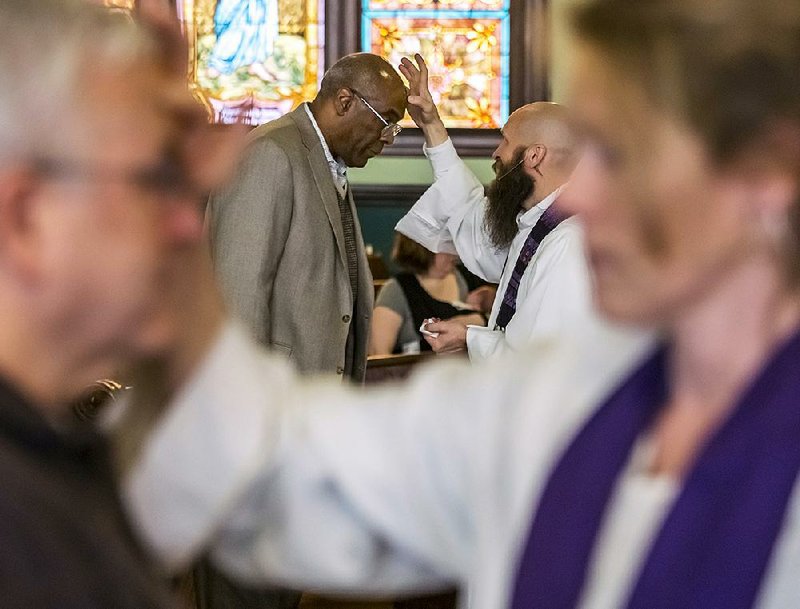Lent, the 40 days that represent the time Jesus spent in the desert before beginning his ministry, is a time during which Christians are in part called to sacrifice or give up something they enjoy, with some abstaining from consuming meat -- but not fish -- on Fridays.
For Jeffery Williams, who manages the Little Rock location of the Memphis-based soul food chain Soul Fish, that translates to purposely overstaffing the restaurant for the inevitable call-out, and ordering enough fish to feed as many as 100 people a day.
"The core of our menu is fish and seafood, but during Lent it goes up dramatically," Williams said of the restaurant's seafood sales, which double around that time. "Fridays are nuts because we're full [of customers], and it's all day long, nonstop."
According to market research firm Nielsen, U.S. retailers sold $1 billion of seafood during Lent. Restaurants such as Soul Fish gear up weeks in advance to respond to increased demand for fish entrees, and help the faithful keep a more recent tradition in observance of a time stretching back 2,000 years.
The word Lent is derived from the Anglo-Saxon word lencten, meaning "spring," according to the United Methodist Church website, and as Lent predates major church splits including that of the Great Schism in 1054 or the later division that formed Protestantism, the holiday remains ecumenical.
The Rev. Erik Pohlmeier, director of faith formation for the Catholic Diocese of Little Rock, said the number 40 is itself significant, reflecting Jesus' time before his ministry; the 40 days and nights of rain that flooded all but those in Noah's Ark, according to Genesis; and the 40 years that Moses and the Israelites spent in the desert before finding the Promised Land.
Fridays, he added, have a perpetual "penitential character" to them.
"The [Catholic] church has always had a combination of both fasting and feasting as both are part of what our lives are -- because we we are living in a reality where there is suffering, where we are anticipating Heaven but we're not there yet," Pohlmeier said. "There's the suffering aspect of human life, but it's marked by hope and the promise of resurrection, and so we have that combination of the reality of suffering and the hope in new life."
Christians who observe Lent generally abstain from a luxury they will notice -- social media has become a popular Lent sacrifice in recent years -- but for Catholicism in particular the rules have evolved. At one time, Catholics were not to eat meat on any Friday throughout the year. At Vatican II in the 1960s when Catholic leaders gathered to review and adapt some church doctrine to apply the church's teachings to modern life, the rule was changed to abstaining from meat only during Lent.
Catholics could then choose to make a different sacrifice on Fridays outside of Lent once the fasting guidelines were updated, but Pohlmeier said that in many cases that part of the rule was missed, while the practice of not eating meat carried on during Fridays, Ash Wednesday and Good Friday.
The practice of forsaking meat on Fridays during Lent isn't limited to Catholics -- more than 155,000 Arkansans, according to the diocese's 2017 official directory -- but Catholics are the most numerous adherents to the Lenten practice. With about 51 million Catholic adults in the United States, according to a 2014 Pew Research study, or about one-fifth of the nation's adult population, sticking with fish on Fridays makes for a noticeable increase in sales.
Lent has affected sales of fish enough that in the past century restaurants have changed their menus to accommodate those six weeks. Chick-fil-A began selling a fish sandwich March 6 -- Ash Wednesday this year -- in parts of the South, although a representative at the Otter Creek franchise location in Little Rock said the change had not been made to menus in central Arkansas.
According to Eliecer Palacios, who owns and operates eight McDonald's locations, the restaurant franchise was among the first to "deviate from the burger option."
Lou Groen, owner of a Cincinnati location in the 1960s, came up with the restaurant's Filet-O-Fish sandwich -- a combination that included Alaskan pollock, cheese and tartar sauce on a bun.
"During Lent, [Groen's] sales -- burger sales especially -- decreased," Palacios said. "He said, 'There's got to be an alternative.'"
Ray Kroc, McDonald's founder, had created the Hula Burger -- made with grilled pineapple and cheese -- as an option that would keep fish out of the equation. Both debuted at the Cincinnati location on Good Friday in 1962, and the 350 Filet-O-Fish sandwiches bought that day far outstripped the six Hula Burgers sold on the same day, earning the fish sandwich a permanent spot on the McDonald's menu.
It's still a popular item, said Palacios, and his restaurants see a 45 percent increase in fish sandwich sales during Lent than any other time of year.
That rise in sales isn't found everywhere; a representative of Hungry Sharks seafood restaurant in Jacksonville said Lent had no effect on its sales.
Ken Lightfoot, owner of Catfish City & BBQ Grill in Little Rock, said sales get a small increase during Lent but that the increase isn't nearly what it used to be.
"It used to be that Good Friday was the biggest day of the year [for sales]," Lightfoot said. "On Ash Wednesday you could tell who was there after church from the ashes on their foreheads."
Lightfoot said in addition to seeing fewer visible observers of Lent stop by for a meal, there are nonreligion-related factors contributing to the diminished increase in patronage at the restaurant during Lent, including an increase in the number of restaurants beginning in the mid-1990s.
Pohlmeier noted that refraining from eating meat on Fridays during Lent is only a small part of the fasting that should take place during Lent. Prayer and alms-giving, he said, also were part of a deeper commitment to God during the weeks leading up to Easter.
"The goal of Lent is not just to see if I can make a sacrifice for 40 days or give up meat on Fridays, but rather it's a renewal of my heart, a refocusing on what are the real values of my life," Pohlmeier said. "There always seems to be a real renewal during Lent. Even people that might not practice faith very consciously at other times of the year seem to recognize Lent as an opportunity for a renewal."
Religion on 04/13/2019


